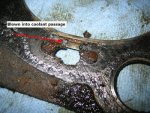Cantrade
Member
- 37
- 0
- 6
- Location
- New Mexico
I use my 1968 Kaiser Deuce to haul a 1000 gallon water tank. I can usually make it up the hill between the water source and our place in 2nd gear but last week I had to downshift to 1st and I noticed a rough idle and white smoke from the exhaust. The engine is a LDT-465-1D that was overhauled in 1989. Truck shows about 22,000 miles but who knows? The problem seemed to be getting worse so here is what I have done so far.
Troubleshooting to date:
- Changed primary, secondary and final fuel filters. No water found in canisters.
- Tested fuel pressure with electric pump running: 5.5 psi at bleed screw between secondary and final filters.
- Pulled in-tank pump and cleaned screen. No problems here.
- Adjusted valve lash. .010” Intake & .025” Exhaust. None were very far out of tolerance.
- Tested injectors by loosening fitting while engine running. Cylinders dropped about the same rpm.
- Removed injectors and pop tested. These are AMBAC P/N: AKN-130SM-6844-B2 and the specification sheets say they should open at 3600-3750 psi Mine opened around 3450 psi and I figured that they had taken a “set” and I adjusted them to 3500 psi. One injector seemed to not seal itself properly and I took the nozzle apart and cleaned it well and retested. It worked then.
- Removed the center bolt from the hydraulic head and inserted a plastic pen to use as a travel indicator. It moved up and down as the engine was turned over by hand so I think it is free.
- Removed the cover of the fuel shut off lever on the injection pump and found the red mark was where it should be. (Nothing has ever been touched on the IP and it was working well prior to this problem.) There was engine oil in the cover. Is this normal?
- The FDC is supposed to have been bypassed but the fuel lines are terminated in the stock place and from the “tee” on the FDC a fuel line goes to the input port of the HH. None of the overflow lines have been blocked.
- The IP has been replaced according to the PO and it looks clean as a whistle inside.
- I checked for water in the oil and oil in the water as well as fuel in the oil. Nothing evident of anything wrong here. (I only drive this truck about 20 miles each month so this could be a not valid test right now.)
- I removed the inlet to the turbo-charger and found the blades intact with no noise and no play in the shaft. The air and exhaust passages are all clear. There is no muffler.
It is beginning to look like I may have a blown head gasket.
- Could a gasket blow and not have any of the usual indications?
- I have seen threads that say the white smoke is caused by over-fueling the engine and other threads say that over-fueling causes black smoke. Anyone know which is right?
- Where can I get the special 7/8” wrenches required to remove the head stud nuts?
Thanks for reading my tale of woe!!


